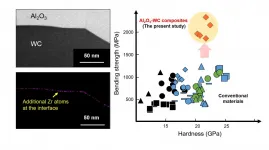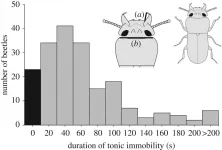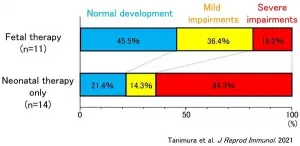(Press-News.org) Pioneering research into how our bodies manufacture the cells that make blood has moved us closer to regrowing tissues and organs. The findings also may let doctors grow the cells for transplantation into people to battle cancer, blood disorders and autoimmune diseases.
Researcher Karen K. Hirschi, PhD, of the Department of Cell Biology and the Robert M. Berne Cardiovascular Research Center at the University of Virginia School of Medicine, has developed a simple and efficient way to generate "hemogenic endothelial cells." These cells are the first step in the production line of blood cells, and Hirschi's new findings provide a blueprint for creating them outside the body.
"By studying how hemogenic endothelial cells develop normally, we gain insights needed to generate them in the lab," Hirschi said. "Now that we have established a method to produce human hemogenic endothelial cells outside of the body, we will continue to improve their production and function as we learn more about the mechanisms that promote their normal development."
Building Blood-Making Factories
Hirschi's latest work, published in a pair of scientific papers, offers important insights into how hemogenic endothelial cells form and how they ultimately give rise to the cells that directly manufacture blood throughout our lives.
Writing in the prestigious journal Science, she and her team reveal a key trigger that causes the endothelial cells to "transdifferentiate," or turn into blood-making factories, during embryonic development. These blood-making (i.e. hemogenic) endothelial cells generate hematopoietic stem and progenitor cells (HSPCs) that have long been used for the treatment of cancer and other diseases. Typically, they are taken from sources such as an individual's bone marrow, but doctors would like to be able to manufacture them quickly and easily for patients on demand. "Generating human hemogneic endothelial cells in the lab from each patient that needs HSPC is the first step toward patient therapies for blood disorders," Hirschi said.
In a paper published nearly simultaneously in Cell Reports, Hirschi unveils a blueprint for creating the hemogenic endothelial cells, the source of HSPCs, outside the body. The secret is a substance called retinoic acid. You may have heard of retinoic acid in association with beauty products, but in this case its responsibilities include triggering genes to cause "hematopoietic transition" - to put more vascular endothelial cells in the business of making blood by producing HSPCs.
The new insights provided by the work "will improve our ability to apply developmental insights to the generation of distinct endothelial cell subtypes for tissue engineering and regenerative medicine," the researchers write in their new paper. "In addition, our system could likely be developed further to optimize the generation of transplantable HSPCs from human hemogenic endothelial cells for clinical therapies."
The approach offers several advances over existing means, including being quicker and less expensive, the researchers note.
"We hope our continued efforts will move us closer to treating both vascular and blood disorders," Hirschi said. "These studies highlight the importance of basic cell and developmental biology research as a foundation for devising strategies for patient-specific clinical therapies."
Hirschi was recruited from Yale in 2019 to join the faculty in the Department of Cell Biology, which has long been interested in addressing how embryos develop and applying this basic knowledge to the repair and regeneration of damaged tissues and organs.
INFORMATION:
Findings Published
The Science paper was authored by Dionna M. Kasper, Jared Hintzen, Yinyu Wu, Joey J. Ghersi, Hanna K. Mandl, Kevin E. Salinas, William Armero, Zhiheng He, Ying Sheng, Yixuan Xie, Daniel W. Heindel, Eon Joo Park, William C. Sessa, Lara K. Mahal, Carlito Lebrilla, Hirschi and Stefania Nicoli. The work was supported by the National Institutes of Health (grants F32HL132475, U54DK106857, 1K99HL141687, R01HL130246, R56DK118728, R01HL146056. R01HL128064, R01DK118728 and R01GM049077) and the American Heart Association (grants 19PRE34380749 and19TPA34890046).
The research team responsible for the Cell Reports paper consisted of Jingyao Qiu, Sofia Nordling, Hema H. Vasavada, Eugene C. Butcher and Hirschi. That work was supported by NIH grants HL128064, U2EB017103, R01-AI130471 and R01-CA228019; CT Innovations grant 15-RMB-YALE-04; Department of Veterans Affairs Merit Review award I01BX002919; the Swedish Society for Medical Research; and a Stanford Dean's Fellowship.
To keep up with the latest medical research news from UVA, subscribe to the Making of Medicine blog at http://makingofmedicine.virginia.edu.
Ceramic matrix composites (CMCs) are incredibly strong materials used in jet engines, gas turbines, and cutting tools for nickel superalloys. Aluminum oxide (Al2O3) is hard and chemically inert, and tungsten carbide (WC) is used as a superhard material, but past efforts to create an Al2O3-WC CMC yielded unsatisfactory results. Recently, a study by Japanese scientists, published in Scientific Reports, shows that adding zirconium atoms results in improved Al2O3-WC CMCs.
Given the potential utility of Al2O3-WC CMCs as superhard materials, researchers around the world have tested several formulations to identify one with a high bending strength, which is a measure of the physical stress a material can be subjected to before it becomes permanently bent or broken. Previously, ...
In a first-of-its-kind study, researchers discovered that light pollution leads to more than just wasted energy and washed-out starlight--it can increase the likelihood of a preterm birth by almost 13%. Laura Argys, professor of economics at the University of Colorado Denver, collaborated with scientists at Lehigh University and Lafayette College to produce this study.
Skyglow, the brightness of the night sky apart from discrete light sources such as the moon and visible stars, is one of the most pervasive forms of light pollution. When you have increased artificial brightness at night, coming from sources like streetlamps, outdoor advertising, and buildings, it reduces your ability to see the dark ...
Aging and lifestyle-related metabolic imbalances, such as hyperglycemia, hyperlipidemia, and oxidative-stress, cause the accumulation of advanced glycation end products (AGEs), including pentosidine (PEN, crosslinked type) and carboxymethyl-lysine (CML, non-crosslinked type). Osteoporosis is a widespread metabolic skeletal disease characterized by diminished bone mineral density (BMD) or bone strength, which increases the risk of fractures.
To date, the association of PEN and CML with osteoporotic fracture has been reported, and the accumulation of AGEs in bone ...
When it comes to drones, the Singapore public is not as keen for them to be used to provide services around their living spaces, finds a study by researchers at the Nanyang Technological University, Singapore (NTU Singapore). However, they are more accepting of drones being used in areas like recreational spots or industrial areas.
There is growing global interest in the use of drones to provide a range of applications - from building inspection to last mile commercial delivery - that promise productivity gains and cost reductions.
In Singapore, the use of drones is picking up, with the government adopting them for various projects in the Smart Nation drive, where technology ...
Cambridge, Massachusetts - They may be the youngest astronomers to make a discovery yet.
This week, 16-year-old Kartik Pinglé and 18-year-old Jasmine Wright have co-authored a peer-reviewed END ...
Across many animal species there is great evolutionary pressure on males, who often engage in combat for the rights to copulation. This phenomenon, called sexual selection, often ends up favoring males with larger weapons, such as horns or pincers. Interestingly, scientists have noted that males endowed with smaller weapons adopt alternative reproductive tactics in some species. For example, instead of fighting other more powerful males, they may try to sneak around or disperse in search of a lonely female.
Variability in sexual behavior according to a male's weapon size has been widely studied. However, it's worth noting that bigger is not always better. Though larger weapons usually help in fights for reproductive rights, they can also be ...
Blood is vital to life, and a healthy body replenishes worn-out blood cells with new ones throughout one's lifetime. If something goes wrong with this process, serious illness will result.
Researchers from the National University of Singapore (NUS) have now discovered a mechanism controlling the replenishment of blood cells, which could have relevance for new treatments for blood cancers and other blood-related diseases.
The international research team, helmed by Dr Akihiko Numata while he was a Postdoctoral Fellow in the laboratory of Professor Daniel Tenen of the Cancer Science Institute of Singapore and Yong Loo Lin School of Medicine ...
Countries around the world are seeing a surge in the number of computer science students. Enrolment in related university programs in the U.S. and Canada tripled between 2006-2016 and Europe too has seen rising numbers. At the same time, the age to start coding is becoming younger and younger because governments in many different countries are pushing K-12 computer science education. Despite the increasing popularity of computer programming, little is known about how our brains adapt to this relatively new activity. A new study by researchers in Japan has examined the brain activity ...
A cross-institutional research group has revealed for the first time in the world that infants with symptomatic congenital cytomegalovirus (CMV) infection who were treated with a combination of immunoglobulin fetal therapy and neonatal therapy with antiviral drugs were less likely to experience the severe aftereffects associated with the infection than those who only received the neonatal therapy.
It is hoped that the number of children suffering severe aftereffects resulting from congenital CMV infection will decrease in the future.
The research group included the following members:
Doctor YAMADA Hideto ...
Tokyo, Japan -- In the marchland of Japan's Oze National Park, keeping track of the deer population has been a difficult and time-consuming task for the park rangers. Now their lives could get much easier, thanks to a novel technique for tracking deer movements using unmanned listening devices developed by researchers at the Institute of Industrial Science, a part of The University of Tokyo.
Monitoring deer numbers is important in Oze and other national parks in Japan because deer are not native to the ecosystem and can have damaging effects on it. Current methods of monitoring deer populations range from traditional techniques such as counting droppings to photographing deer at night using automated cameras or from above during the day using unmanned aerial vehicles ...




